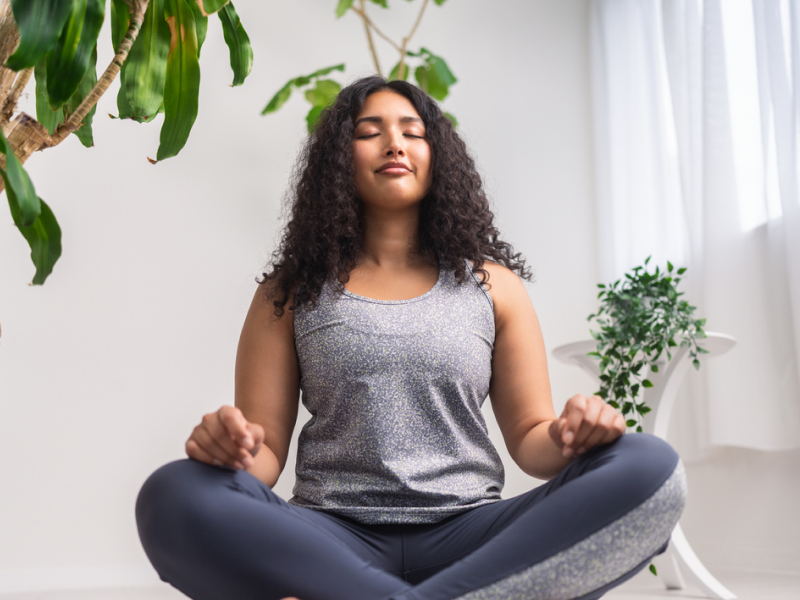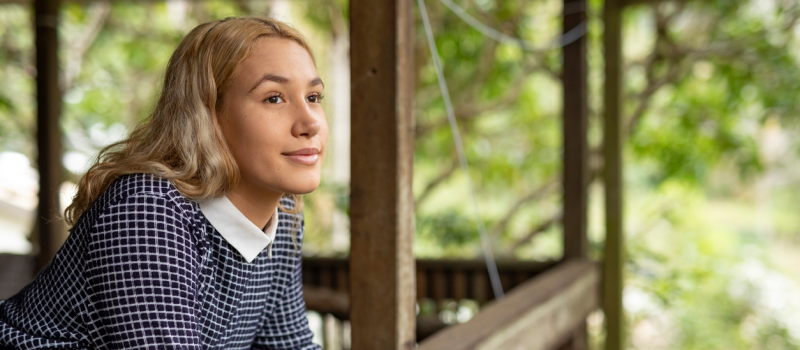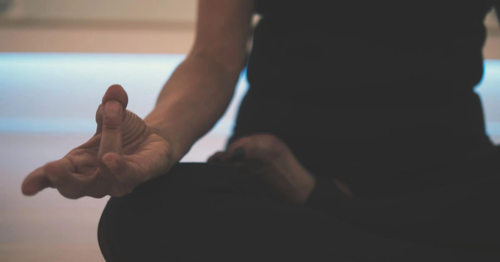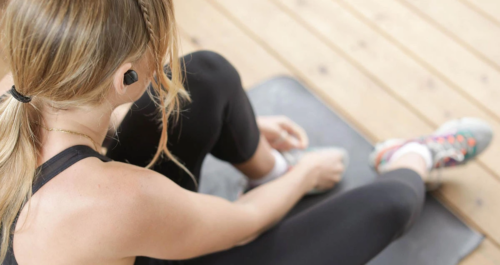
Table of Contents
A Beginner’s Guide to Mindfulness Practices

Written By: Kera Passante, MS, LPC

Clinically Reviewed By: Dr. Don Gasparini
Updated: September 14, 2023
7 min.
Mindfulness practice involves using different tools and techniques to help your mind become more aware of the present moment. The practice encourages not being critical, not holding on too tightly, and accepting the whole journey, even when it's tough.
Learn more about our Clinical Review Process
Table of Contents
Many of us find ourselves constantly multitasking, our mind’s racing from one thought to another. This constant mental chatter can lead to stress, anxiety, and a sense of disconnectedness from the present moment. Mindfulness, a practice rooted in ancient Eastern traditions, particularly Buddhism, offers a powerful antidote to these modern challenges. Keep reading to learn more about what mindfulness is and how to craft your own mindfulness practice.
What is mindfulness?
Mindfulness is the practice of being fully present and engaged in the current moment without judgment. It involves paying close attention to your thoughts, feelings, bodily sensations, and the world around you. By cultivating mindfulness, you can learn to appreciate the richness of each moment, reduce stress, and improve your overall well-being.
Research shows that mindfulness-based therapy effectively supports treatment for anxiety, depression, trauma, substance use disorders, stress disorders, and other mental health issues. According to a 2010 analysis of many different studies, elements of mindfulness practices such as mindfulness meditation, guided meditation, deep breathing, and body scans have been shown to reduce symptoms of mental health issues and lessen fatigue, pain, insomnia, and negative thoughts. Preliminary studies even show that mindfulness may benefit the immune system and overall physical health, in addition to its documented mental health benefits.
There are three primary techniques to beginning mindfulness practice. In order to begin, carve out some time and create a safe space yourself. Even just one minute of mindfulness can be a great introduction if you’re unfamiliar with or hesitant to begin. Over time, as you feel more comfortable, add to your time and remember to release any pressure, judgments, or expectations of yourself or the practice.
Also, note that it is natural for your mind to wander. When it does, let go of the interruption by returning to the tool. Your eyes can be closed, or if that is not comfortable, relax your eyes on one spot. Make sure the body is comfortable. For some, sitting in a chair is more comfortable. For others, sitting on the floor or even lying down can be most comfortable. Whichever position feels right for your body is the best way to begin to practice mindfulness.
A simple guide to mindfulness for beginners
Follow these steps to build awareness, decrease stress, bring attention to your breath, and ease your negative thoughts:
1. Observe your breath
Without changing anything, notice your breathing. Feel your inhales and your exhales. Notice the natural expansion and contraction of your body as you breathe. After a few moments, begin to slow your breathing down, calmly lengthening the inhalations and exhalations again, simply observing your breath and how it feels.
2. Focus your mind on a word/words that help to anchor, ground, center, inspire, or uplift you
Examples include:
- Peace
- Let go
- I am
Keep repeating the word to yourself to increase the benefits of this mindfulness-based stress reduction practice and to make sure your mind remains centered.
3. Body scan
The mindfulness exercise of body scanning helps to bring awareness to parts of the body, scanning from the top of the head to the tip of the toes. Here’s an example of a body scan: Become aware of your head. Feel your head. Become aware of your face. Feel your face.
Become aware of your neck, throat, and shoulders. Feel your neck, throat, and shoulders.
Travel down the entire body with the intention of awareness, observation, and feeling without judgments
Try all of the techniques, and whichever one you connect with most, practice it consistently for a period of time. For those who are new to practicing mindfulness, know that with consistency, the experience will gradually come with more ease. As you become more comfortable, you will begin to notice stronger effects and be able to increase your mindfulness time.
That said, even if you are practicing mindfulness regularly, some days will be more difficult than others. Note any differences that you experience after the practice and throughout your days. The more you practice mindfulness, however, the easier it will be to calm your mind, remain present in the moment, and support your own mental health.
Join the Charlie Health Library
Get mental health updates, research, insights, and resources directly to your inbox.
You can unsubscribe anytime.
How does mindfulness support mental health?
Here are some ways that mindfulness supports mental health.
Stress reduction
Mindfulness practices, such as meditation and deep breathing, help people become more aware of their stressors and reactions to them. By staying present and non-judgmental, mindfulness allows people to manage stress more effectively. This can lead to decreased cortisol levels (the stress hormone) and a reduction in overall stress levels.
Anxiety management
Mindfulness can be a valuable tool for managing anxiety disorders. It teaches people to observe their anxious thoughts and physical sensations without judgment. This awareness can reduce the intensity of anxiety and prevent rumination, ultimately helping individuals gain better control over their anxious responses.
Depression prevention and management
Mindfulness-based interventions have shown promise in preventing and managing depression. Mindfulness practices encourage people to focus on the present moment, promoting a break from negative thought patterns that often contribute to depressive episodes. It can also increase feelings of self-compassion, which is vital for people struggling with depression.
Improved emotional regulation
Mindfulness cultivates emotional awareness, enabling people to recognize and accept their emotions without reacting impulsively. This skill empowers individuals to respond to challenging emotions in a healthier and more adaptive manner, reducing emotional outbursts and impulsivity.
Enhanced self-awareness
Mindfulness encourages self-reflection and self-awareness. People gain insights into their behavior and reactions by paying attention to their thoughts and feelings. This self-awareness can help identify harmful thought patterns and habits, allowing for positive changes in behavior and self-perception.
Better concentration and focus
Mindfulness exercises, such as meditation, strengthen the attention muscle. Practitioners learn to sustain their focus on the present moment, improving their ability to concentrate and resist distractions. This can be particularly helpful for people with attention disorders or those who struggle with productivity.
Increased resilience
Mindfulness helps people develop resilience by teaching them to adapt and bounce back from adversity. By accepting and processing difficult emotions, individuals become better equipped to navigate life's challenges, reducing the risk of prolonged periods of distress.
Improved relationships
Mindfulness fosters better communication and empathy, which can enhance relationships. When people are more present and attentive, they're better at listening, understanding, and responding to the needs of others, which can strengthen interpersonal connections.

Better sleep
Mindfulness practices can improve sleep quality by reducing racing thoughts and promoting relaxation. People who practice mindfulness before bedtime often experience more restful sleep.
Pain management
Mindfulness-based techniques have been shown to help people cope with chronic pain conditions. By directing their attention away from pain and toward the present moment, people can reduce the suffering associated with pain.
How can you practice mindfulness in a group?
Practicing mindfulness in a physical or virtual group – as all clients do at Charlie Health – can offer a sense of connection and shared purpose, making it easier to maintain a consistent mindfulness practice. Here's how mindfulness practice works in a group:
Group meditation sessions
- Start with group meditation sessions. These can be guided by an experienced meditation teacher or simply led by one member taking turns.
- Choose a quiet and comfortable space where everyone can sit or lie down. It's essential to create an environment free from distractions.
- Set a specific duration for the meditation session, such as 15, 30, or 45 minutes, depending on the group's preferences and experience levels.
- Begin with a few minutes of mindful breathing to settle in, then proceed with the chosen meditation practice, whether it's focused attention on the breath, body scan, loving-kindness meditation, or any other form of meditation.
Mindful communication
- Engage in mindful communication exercises. Participants take turns speaking while others listen attentively without interrupting or judging.
- Practice speaking from a place of mindfulness and explore active listening techniques to create a deeper connection within the group.
Group reflection and sharing
- After each mindfulness session, set aside time for group reflection and sharing. Allow participants to express their experiences, insights, and challenges.
- Encourage a non-judgmental and supportive atmosphere where members can learn from each other.
Group support
- Foster a sense of support and accountability within the group. Encourage members to check in with each other regularly, providing motivation and encouragement to maintain a consistent mindfulness practice.
Mindful eating
- In some instances, a group may arrange mindful eating sessions where the group comes together to share a meal in silence. Encourage participants to savor each bite, paying attention to taste, texture, and sensations.
- Discuss the experience afterward, sharing observations and insights gained during the meal.
Chair yoga
- Some groups may incorporate intentional movement into their mindfulness practices. Chair yoga is a mindfulness technique that involves gentle movements, stretches, and breathing exercises performed while sitting in a chair. This practice promotes relaxation, body awareness, and stress reduction, making it accessible to a wide range of people, including those with physical challenges.
Mindfulness at Charlie Health
Mindfulness practice, meditation practice, and other self-soothing practices are some of the many tools used at Charlie Health’s virtual Intensive Outpatient Program (IOP).
Charlie Health is a personalized treatment program that combines family therapy, individual therapy, and group sessions for teens and young adults who need more than once-weekly support. Charlie Health believes in a comprehensive recovery model, and our expert clinicians incorporate many different therapeutic techniques, including mindfulness practices, into clients’ personalized treatment plans.





